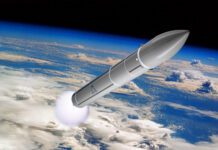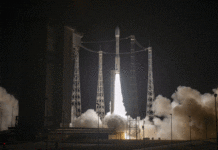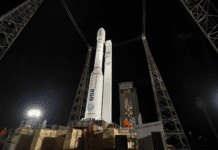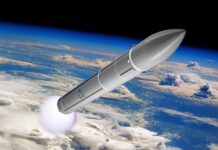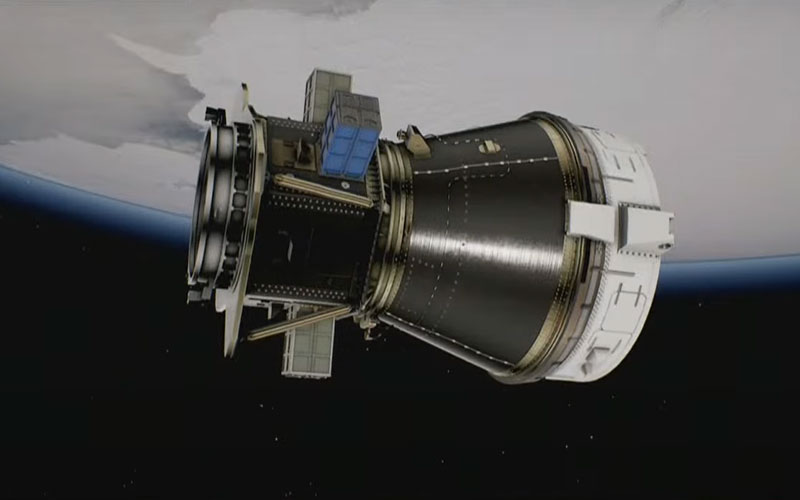
A pair of payloads that were among 12 carried to orbit aboard the Arianespace-managed Vega VV23 flight failed to be deployed and likely burned up in the atmosphere still attached to the rocket’s upper stage.
The Vega VV23 flight was launched on October 9 at 01:36 UTC from the Guiana Space Centre in French Guiana. The rocket carried the THEOS-2 and FORMOSAT-7R/TRITON satellites as its primary payloads and ten smaller satellites as secondary payloads.
Following a successful launch, Arianespace published a press release confirming that the two primary payloads and eight of the ten secondary payloads had been deployed. However, the launch services provider added that “the separation of the last 2 cubesats is still to be confirmed.”
The launch utilized the Small Spacecraft Mission Service (SSMS) dispenser, which was designed by SAB Aerospace for Avio and is operated by Arianespace with the support of SAB Launch Services.
In an email sent by Arianespace to the affected teams that European Spaceflight has seen, the launch services provider explained that the ESTCube-2 and ANSER-Leader cubesats likely failed to separate from their respective deployers.
“Following the VEGA VV23 launch last Sunday, ARIANESPACE has now the strong suspicion that your satellites ESTCube-2 and ANSER-Leader were unfortunately not separated from their respective deployers,” said the email.
Arianespace went on to explain that its suspicion was based on three facts.
- “The launcher telemetry on the end-switch of the deployers, indicating the cubesat release from the deployer, was not received. This could be just an electrical failure of the end-switch or an actual indication of the non-release of the cubesats.”
- “The NORAD data indicates that 10 objects are in orbit following the launch, instead of 12, which would have been the nominal situation.”
- “Your teams have not been able to establish a connection with these satellites since the launch, despite your extended efforts.”
ESTcube-2 was built by the Estonian Student Satellite Foundation and was supposed to test an innovative plasma brake that could be used for end-of-life satellite disposal.
ANSER-Leader is one of three ANSER satellites that were launched aboard the VEGA VV23 flight for the Spanish National Institute of Aerospace Technology (INTA) along with ANSER-Follower 1 and ANSER-Follower 2.
The satellites were designed to work together to monitor the quality of water in Spanish swamps and reservoirs. The two follower satellites were to maintain formation by following the lead satellite, which would be the only satellite to communicate directly with the ground. However, the leader and follower designations are not set in stone.
According to an INTA spokesperson, all three satellites are “fully equipped and programmed to communicate with the ground directly.” “Any of them can take over the role of the leader if in the near future it is decided to operate in this “only one node communicating with the ground” way.” The spokesperson also confirmed that “at this point, we are nominally operating the remaining two [satellites].”
In terms of the value of the data that will be collected, the loss of ANSER-Leader will not have a significant impact. According to the INTA spokesperson, the lead satellite carried a panchromatic camera (APIS), and the two followers carried spectrometers (CINCLUS).
“The “real” science is done with the spectrometers (measurement of certain chemical markers such as chlorophyll and phycocyanin that allow us to estimate water quality),” the spokesperson explained. “The objective of APIS was to provide cloud images to complement the spectra at the same time as the spectra were taken, but such images are readily available from other sources.”
Additionally, the APIS system has already flown aboard precious cubesat missions, so the technology is already qualified for flight.
The final element of the ANSER mission is the passive control system. The satellites are not equipped with any propulsion and instead control their relative position by deploying flaps that utilize trace amounts of air at the top of the atmosphere. The satellites were expected to study, implement, and validate the system. According to INTA, “mastering the mechanism with two satellites would be more than enough progress to make the mission a success in this aspect as well.”
Update: This article was updated on 17 October to include clarification that the two ANSER-Follower satellites were capable of operating without ANSER-Leader.


